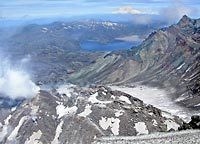Three years ago this month, hundreds of small earthquakes heralded the renewal of volcanic activity at the Cascade peak after an 18-year lull. Since then, the volcano has been a perpetual-motion machine.

|
| ©EVAM CALDWELL / AP |
| Gases escape the growing dome inside the Mount St. Helens' crater overlooking Spirit Lake in June. Mount Rainier is in the background. |
"It's been an amazing run," said Seth Moran, a seismologist with the U.S. Geological Survey's Cascades Volcano Observatory in Vancouver, Wash. "I never thought this eruption would last this long. And although things have slowed, there's no signs of it stopping any time soon."
The slowdown is letting Moran and other scientists take a closer look at giant Mount Rainier and other potentially dangerous Cascade volcanoes and apply the lessons learned from Mount St. Helens.
"Mount St. Helens woke up in a hurry three years ago," Moran said, "which shows that we have to be prepared for what these volcanoes can do. You want to be ahead of the game by being able to detect even small changes."
Small changes at Mount St. Helens alerted scientists to the volcano's reawakening. Beginning at 2 a.m. Sept. 23, 2004, instruments detected hundreds of tiny, unfelt earthquakes beneath the crater. Three days later, as the quakes grew stronger, observatory officials issued an official "Notice of Volcanic Unrest."
The volcano, after blasting a hole in the crater floor Oct. 1, 2004, began to spew occasional spectacular plumes of ash thousands of feet into the atmosphere. The mountain, with a final explosive outburst 2 ½ years ago, then focused all its energy on relentlessly churning out a huge dome of lava.
The dome now rises higher than the Empire State Building. The expanding mound surpasses the dome built during sporadic lava eruptions after the volcano's May 18, 1980, blast that sliced 1,314 feet off its top and killed 57 people.
The mountain snoozed after a burst of lava in 1986, reloading its supply of molten rock in a chamber three to five miles below the crater. Tremendous pressure built, triggering the march of magma to the surface.
Moran said tens of earthquakes are occurring daily compared with hundreds a year ago.
The current eruption has led to more sophisticated instruments being placed around Mount St. Helens, including four 800-foot-deep bore holes about five miles from the crater. Strainmeters at the bottom of each hole detect the subtlest ground movements. The strainmeters, part of the national Plate Boundary Observatory program, can measure ground shifts as tiny as 0.04 inch in a 620-mile-wide area.
Additional digital time-lapse cameras also have been installed on the crater's rim to monitor changes and movements in the lava dome.
The volcano's slowdown has allowed volcano scientists to give more attention to Mount Rainier, which is considered the Cascades' most dangerous volcano because it poses a threat to a large population.
A new seismic station and three GPS instruments to detect ground movements have been installed around the 14,410-foot-high peak in the past two weeks, with more to come next year.
"Installing these instruments has been in the plans for several years, so they're going to help us keep an eye on this mountain," said Steve Malone, a University of Washington research professor. "We want as much warning as possible if Mount Rainier starts acting up."
Malone, who has studied Cascade earthquakes for four decades, said he doesn't expect the Mount St. Helens eruption to stop soon. "It'll be a gradual quietening, but I won't make any predictions about this volcano because it's fooled me many times before," he said.
"If the activity suddenly quit, then I'd be surprised."



Reader Comments
to our Newsletter